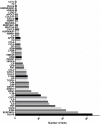Human Immune System Diseasome Networks and Female Oviductal Microenvironment: New Horizons to be Discovered
- PMID: 35154249
- PMCID: PMC8829125
- DOI: 10.3389/fgene.2021.795123
Human Immune System Diseasome Networks and Female Oviductal Microenvironment: New Horizons to be Discovered
Abstract
Human hypofertility and infertility are two worldwide conditions experiencing nowadays an alarming increase due to a complex ensemble of events. The immune system has been suggested as one of the responsible for some of the etiopathogenic mechanisms involved in these conditions. To shed some light into the strong correlation between the reproductive and immune system, as can be inferred by the several and valuable manuscripts published to date, here we built a network using a useful bioinformatic tool (DisGeNET), in which the key genes involved in the sperm-oviduct interaction were linked. This constitutes an important event related with Human fertility since this interaction, and specially the spermatozoa, represents a not-self entity immunotolerated by the female. As a result, we discovered that some proteins involved in the sperm-oviduct interaction are implicated in several immune system diseases while, at the same time, some immune system diseases could interfere by using different pathways with the reproduction process. The data presented here could be of great importance to understand the involvement of the immune system in fertility reduction in Humans, setting the basis for potential immune therapeutic tools in the near future.
Keywords: asthma; biological network; diseasome; human; immune system; immunological disease; oviductal environment; rheumatoid arthritis.
Copyright © 2022 Taraschi, Cimini, Colosimo, Ramal-Sanchez, Moussa, Mokh, Valbonetti, Capacchietti, Tagaram, Bernabò and Barboni.
Conflict of interest statement
The authors declare that the research was conducted in the absence of any commercial or financial relationships that could be construed as a potential conflict of interest.
Figures






Similar articles
-
A protein isolated from human oviductal tissue in vitro secretion, identified as human lactoferrin, interacts with spermatozoa and oocytes and modulates gamete interaction.Hum Reprod. 2013 May;28(5):1297-308. doi: 10.1093/humrep/det016. Epub 2013 Feb 20. Hum Reprod. 2013. PMID: 23427237
-
Oviductal extracellular vesicles (oviductosomes, OVS) are conserved in humans: murine OVS play a pivotal role in sperm capacitation and fertility.Mol Hum Reprod. 2018 Mar 1;24(3):143-157. doi: 10.1093/molehr/gay003. Mol Hum Reprod. 2018. PMID: 29370405 Free PMC article.
-
Fibronectin From Oviductal Cells Fluctuates During the Estrous Cycle and Contributes to Sperm-Oviduct Interaction in Cattle.J Cell Biochem. 2017 Nov;118(11):4095-4108. doi: 10.1002/jcb.26067. Epub 2017 May 31. J Cell Biochem. 2017. PMID: 28419524
-
Oviductal secretion and gamete interaction.Reproduction. 2015 Jan;149(1):R1-R14. doi: 10.1530/REP-14-0145. Epub 2014 Sep 4. Reproduction. 2015. PMID: 25190504 Review.
-
Importance of sperm-binding assays for fertility prognosis of porcine spermatozoa.Theriogenology. 2005 Jan 15;63(2):470-84. doi: 10.1016/j.theriogenology.2004.09.025. Theriogenology. 2005. PMID: 15626412 Review.
Cited by
-
Multicentric Assessment of a Multimorbidity-Adjusted Disability Score to Stratify Depression-Related Risks Using Temporal Disease Maps: Instrument Validation Study.J Med Internet Res. 2024 Jun 24;26:e53162. doi: 10.2196/53162. J Med Internet Res. 2024. PMID: 38913991 Free PMC article.
References
-
- Almiñana C. (2015). Snooping on a Private Conversation between the Oviduct and Gametes/Embryos. Anim. Reprod. 12, 366–374.
-
- Ballester L., Romero-Aguirregomezcorta J., Soriano-Úbeda C., Matás C., Romar R., Coy P. (2014). Timing of Oviductal Fluid Collection, Steroid Concentrations, and Sperm Preservation Method Affect Porcine In Vitro Fertilization Efficiency. Fertil. Sterility 102, 1762–1768.e1. 10.1016/j.fertnstert.2014.08.009 - DOI - PubMed
LinkOut - more resources
Full Text Sources
Research Materials

